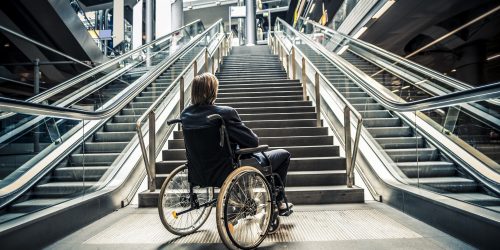

By Aidan Rubel
LOS ANGELES — Two weeks into my first year at UCLA, I was planning to walk to the Fresh Prince of Bel-Air house in Brentwood. It would be a nice way to get alone time, I thought.
Instead, though, I decided to shoot around at the Hitch Basketball Courts. In a one-on-one against another student, I jumped for the ball and landed on his foot, breaking my ankle in three places and tearing entirely through multiple ligaments.
After waiting five hours to be seen at the emergency room of the Ronald Reagan Medical Center, I was sent home, and got picked up by my mother. Luckily, I only live 30 minutes away from school. Otherwise I don’t know what I would have done.
Getting back to school a week later, I was faced with a dilemma: how do I get to class? I could not touch the ground with my right foot for two months, and was in a boot for another two. It was impossible to walk up and down the hill to get to classes, and uneconomical to take an Uber everyday, so I decided to look into my options.
After a few hours of combing through UCLA’s Center for Accessible Education (CAE) website, and doing supplemental research into each of their different programs, I finally found out what I could do: I could start using BruinAccess! BruinAccess is a service that provides shuttles to permanently and temporarily disabled students.
To do this, I would have to officially register with the CAE, which would take four weeks. Four weeks of school that I could not afford to miss because I could not walk to class.
According to the CAE’s website this wait is still the case, with applications taking up to four weeks to review during peak times of the year. The CAE claims to help expedite the application process if you have a temporary disability like mine, but considering the CAE’s need for documentation and a review period, it still takes a lot of time to get the accommodations you need.
But what if a student doesn’t have documentation for their disability? It costs a substantial amount of money and time, especially without insurance, to be able to go to an emergency room, endocrinologist, psychiatrist, or any other medical professional and receive the documentation necessary to receive “reasonable” accommodation by the CAE.
The first problem, which could be easily overlooked, is that it takes a student a few hours of research to learn about the existence of the CAE and its programs. If it takes this long, then it is neither accessible nor known about by most students, making the equal opportunity that the CAE claims to strive for impossible to achieve.
Sara Smith, Erin Woodhead, and Christina Chen-Newman, the authors of “Disclosing Accommodation Needs: Exploring Experiences Of Higher Education Students With Disabilities,” state that, as previously mentioned, the current process that students are required to navigate to receive accommodations causes many to lose out on the services to begin with. The CAE’s current approach is known as the “individualized accommodations” approach, and is often deemed an institutional barrier that discriminates against disabled students.
Let’s say that a student is able to navigate through the ins-and-outs of the individualized accommodations process and receives accommodations. The “equal opportunity” that accommodations provide are sadly a farce. Once disabled students gain the accommodations that they need, they may not even end up utilizing them due to discomfort with self-advocating.
This discomfort is not unfounded. Smith et al. find that “faculty attitudes are a significant obstacle, including unwillingness to adapt content and questioning disability authenticity”.
This is no surprise to any UCLA student, where countless professors continuously refuse, despite a global pandemic and the existence of immunocompromised students, to adapt their courses for online learning unless forced by their respective departments.
This problem is exemplified ten-fold for disabled students, with virtually every “unreasonable” request being met with backlash. Understandably, this experience makes disabled students less likely to self-advocate in the future.
The reasoning laid out thus far does not begin to scratch the surface of the problems faced by disabled students in their fight for equitable treatment, from negative peer attitudes to the invalidation of “invisibly” disabled students. However, what is important to know is that there is a major problem — one that UCLA is readily able to take steps to resolve.
These problems are not limited to UCLA. In fact, it is a problem at essentially every institution of higher education in the U.S. and across the world.




